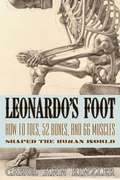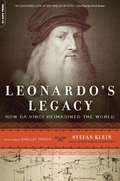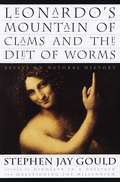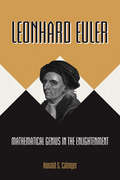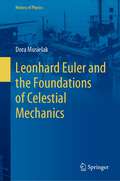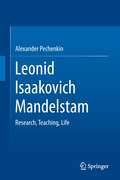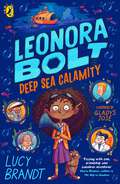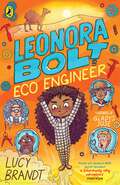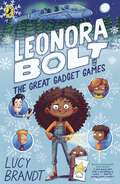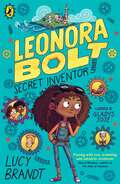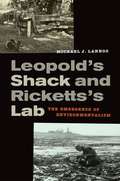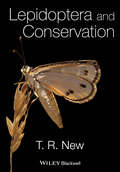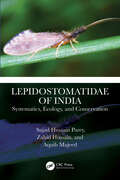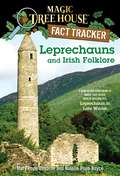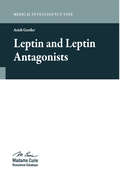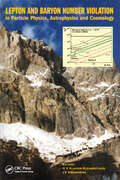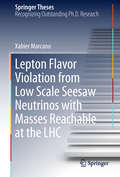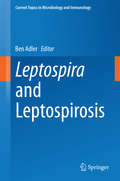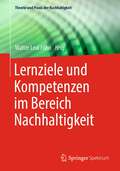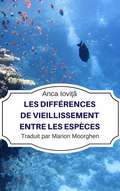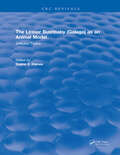- Table View
- List View
Leonardo's Foot
by Carol Ann RinzlerA Selection of the Scientific American, History, and BOMC2 Book Clubs"An in-depth look at the anatomy and history of feet reveals their often overlooked importance in human evolution, medicine and art." -Science News"Stylish, informative, entertaining, and pleasantly personal . . . Whether Rinzler is exploring how our feet explain or illuminate such topics as evolution, disability, racism, diet, or desire, she maintains a fascinating perspective on the peculiarities of being human." -Rain Taxi Review of Books"This neat little book draws a clear picture of our feet, providing understanding that extends far beyond the obvious. Readers often like to walk away from a book feeling they learned something-that the author left them with a new way to look at an old idea, and this book fulfills that need." -City Book Review"Rinzler lifts the lowly human foot to new heights in this appealing book." -Booklist (starred review)Leonardo's Foot stretches back to the fossil record and forward to recent discoveries in evolutionary science to demonstrate that it was our feet rather than our brains that first distinguished us from other species within the animal kingdom. Taking inspiration from Leonardo da Vinci's statement that "the human foot is a masterpiece of engineering and a work of art," Carol Ann Rinzler leads us on a fascinating stroll through science, medicine, and culture to shed light on the role our feet have played in the evolution of civilization.Whether discussing the ideal human form in classical antiquity, the impressive depth of the arching soles on the figures in Sandro Botticelli's Birth of Venus, an array of foot maladies and how they have affected luminaries from Lord Byron to Benjamin Franklin, or delving into the history of foot fetishism, Rinzler has created a wonderfully diverse catalog of details on our lowest extremities. This is popular science writing at its most entertaining-page after page of fascinating facts, based around the playful notion that appreciating this often overlooked part of our body is essential to understanding what it is to be human.Carol Ann Rinzler, a former nutrition columnist for the New York Daily News, has contributed to a number of publications, including the New York Times. She is the author of more than twenty books on health and medicine, including Nutrition for Dummies, an international bestseller translated into fourteen languages.
Leonardo's Legacy: How Da Vinci Reimagined the World
by Stefan KleinRevered today as, perhaps, the greatest of Renaissance painters, Leonardo da Vinci was a scientist at heart. The artist who created theMona Lisaalso designed functioning robots and digital computers, constructed flying machines and built the first heart valve. His intuitive and ingenious approach-a new mode of thinking-linked highly diverse areas of inquiry in startling new ways and ushered in a new era. InLeonardo’s Legacy, award-winning science journalist Stefan Klein deciphers the forgotten legacy of this universal genius and persuasively demonstrates that today we have much to learn from Leonardo’s way of thinking. Klein sheds light on the mystery behind Leonardo’s paintings, takes us through the many facets of his fascination with water, and explains the true significance of his dream of flying. It is a unique glimpse into the complex and brilliant mind of this inventor, scientist, and pioneer of a new world view, with profound consequences for our times.
Leonardo's Mountain of Clams and the Diet of Worms: Essays on Natural History
by Stephen Jay Gould"Leonardo's Mountain of Clams and the Diet of Worms" is the newest collection of best-selling scientist Stephen Jay Gould's popular essays from Natural History magazine (the longest-running series of scientific essays in history). It is also the first of the final three such collections, since Dr. Gould has announced that the series will end with the turn of the millennium. In this collection, Gould consciously and unconventionally formulates a humanistic natural history, a consideration of how humans have learned to study and understand nature, rather than a history of nature itself. With his customary brilliance, Gould examines the puzzles and paradoxes great and small that build nature's and humanity's diversity and order. In affecting short biographies, he depicts how scholars grapple with problems of science and philosophy as he illuminates the interaction of the outer world with the unique human ability to struggle to understand the whys and wherefores of existence.
Leonhard Euler
by Ronald S. CalingerThis is the first full-scale biography of Leonhard Euler (1707-83), one of the greatest mathematicians and theoretical physicists of all time. In this comprehensive and authoritative account, Ronald Calinger connects the story of Euler's eventful life to the astonishing achievements that place him in the company of Archimedes, Newton, and Gauss. Drawing chiefly on Euler's massive published works and correspondence, which fill more than eighty volumes so far, this biography sets Euler's work in its multilayered context--personal, intellectual, institutional, political, cultural, religious, and social. It is a story of nearly incessant accomplishment, from Euler's fundamental contributions to almost every area of pure and applied mathematics--especially calculus, number theory, notation, optics, and celestial, rational, and fluid mechanics--to his advancements in shipbuilding, telescopes, ballistics, cartography, chronology, and music theory.The narrative takes the reader from Euler's childhood and education in Basel through his first period in St. Petersburg, 1727-41, where he gained a European reputation by solving the Basel problem and systematically developing analytical mechanics. Invited to Berlin by Frederick II, Euler published his famous Introductio in analysin infinitorum, devised continuum mechanics, and proposed a pulse theory of light. Returning to St. Petersburg in 1766, he created the analytical calculus of variations, developed the most precise lunar theory of the time that supported Newton's dynamics, and published the best-selling Letters to a German Princess--all despite eye problems that ended in near-total blindness. In telling the remarkable story of Euler and how his achievements brought pan-European distinction to the Petersburg and Berlin academies of sciences, the book also demonstrates with new depth and detail the central role of mathematics in the Enlightenment.Some images inside the book are unavailable due to digital copyright restrictions.
Leonhard Euler and the Foundations of Celestial Mechanics (History of Physics)
by Dora MusielakThe intention of this book is to shine a bright light on the intellectual context of Euler’s contributions to physics and mathematical astronomy. Leonhard Euler is one of the most important figures in the history of science, a blind genius who introduced mathematical concepts and many analytical tools to help us understand and describe the universe. Euler also made a monumental contribution to astronomy and orbital mechanics, developing what he called astronomia mechanica. Orbital mechanics of artificial satellites and spacecraft is based on Euler’s analysis of astromechanics. However, previous books have often neglected many of his discoveries in this field. For example, orbital mechanics texts refer to the five equilibrium points in the Sun-Earth-Moon system as Lagrange points, failing to credit Euler who first derived the differential equations for the general n-body problem and who discovered the three collinear points in the three-body problem of celestial mechanics. These equilibrium points are essential today in space exploration; the James Webb Space Telescope (successor to the Hubble), for example, now orbits the Sun near L2, one of the collinear points of the Sun-Earth-Moon system, while future missions to study the universe will place observatories in orbit around Sun-Earth and Earth-Moon equilibrium points that should be properly called Euler-Lagrange points. In this book, the author uses Euler’s memoirs, correspondence, and other scholarly sources to explore how he established the mathematical groundwork for the rigorous study of motion in our Solar System. The reader will learn how he studied comets and eclipses, derived planetary orbits, and pioneered the study of planetary perturbations, and how, old and blind, Euler put forward the most advanced lunar theory of his time.
Leonid Isaakovich Mandelstam
by Alexander PechenkinThis biography of the famous Soviet physicist Leonid Isaakovich Mandelstam (1889-1944), who became a Professor at Moscow State University in 1925, describes his contributions to both physics and technology, as well as discussing the scientific community which formed around him, usually called the Mandelstam school. Mandelstam's life story is thereby placed in its proper cultural context. The following more general issues are taken under consideration: the impact of German scientific culture on Russian science; the problems and fates of Russian intellectuals during the revolutionary and post-revolutionary years; the formation of the Soviet Academy of Sciences; and transformation of the system of higher education in the USSR during the 1920's and 1930's. The author shows that Mandelstam's fundamental writings and his lectures notes allow to reconstruct his philosophy of science and his approach to the social and ethical functions of science and science education. That reconstruction is enhanced through extensive use of hitherto unpublished archival material as well as the transcripts of personal interviews conducted by the author.
Leonora Bolt: Deep Sea Calamity (Leonora Bolt: Secret Inventor #2)
by Lucy BrandtTHE SECOND LAUGH-OUT-LOUD ADVENTURE FOR LEONORA BOLT, SECRET INVENTOR.'Fizzing with fun, friendship and fabulous inventions!' - Maria Kuzniar, The Ship of Shadows Leonora isn't supposed to be building a submarine in a tree. Or turning the local wildlife luminous. In fact, she is supposed to be keeping her head down and drawing no attention - because Leonora Bolt is an inventor in secret.But she can't stop thinking of the clues she found to her missing parents' location. So, deep in hiding in Snorebury, desperately trying to avoid being discovered by her evil uncle, Leonora is hatching a plan.So what if involves launching a homemade submarine into the middle of the ocean, accompanied only by a couple of friends and an otter with particularly sensitive whiskers? For when disaster strikes, Leonora's wackiest plan might just be her most brilliant yet...
Leonora Bolt: Eco Engineer (Leonora Bolt: Secret Inventor #3)
by Lucy BrandtBook 3 in the LEONORA BOLT: SECRET INVENTOR seriesLeonora Bolt makes amazing gadgets from any old junk. And her inventions have already stopped villainous Uncle Luther TWICE, though she hasn't rescued her super-scientist parents from him - yet.Leonora and her pals find clues that lead them to Luther's latest evil plan. It's an amusement park called Brightworld built in a desert, under a massive snow globe - and it's terrible for the environment!But when all their fancy-pants gadgets fail in the hot-hot heat, it's down to Leonora to use her eco-engineering imagination. Can she invent something to shut down Brightworld and save her parents - before there's a meltdown?With nothing but courage and Leonora's trusty tool belt to hand, the gang must battle swirling sandstorms, navigate plunging canyons and finish Uncle Luther...FOD GOOD!Praise for LEONORA BOLT:'A hilariously silly adventure' - The Guardian'Fizzing with fun, friendship and fabulous inventions!' - Maria Kuzniar, author of The Ship of Shadows'A joyous story' - i
Leonora Bolt: The Great Gadget Games (Leonora Bolt: Secret Inventor #4)
by Lucy BrandtThe fourth hilarious book in the brilliant STEM adventure series Leonora Bolt. With glorious illustrations by Gladys Jose throughout.It's Leonora first Christmas, and the brilliant young inventor is feeling festive! She's made presents, Mildred's boiling cabbage for the candy canes (yuck!), and best friend Jack's brought along . . .an invite to the Great Gadget Games?!Her villainous Uncle Luther is behind this new inventing show, and planning on stealing the creations made by the very talented contestants. And in ANOTHER twist, the judges of the competition are two people very dear to Leonora's heart.Leonora HAS to enter - it's her best-ever chance to finally stop Luther's dangerous games! But she can't enter as herself - he'll never allow that - so she'll need a foolproof disguise, and a brilliant idea for a winning invention . . .Violet Baudelaire meets Peanut Jones in this epic STEM-themed adventure about believing in your brainpower - and yourself.
Leonora Bolt: Secret Inventor (Leonora Bolt: Secret Inventor #1)
by Lucy Brandt'Fizzing with fun, friendship and fabulous inventions!' - Maria KuzniarWARNING: EPIC INVENTIONS AND SECRET SOCIETIES AHEAD . . .Leonora Bolt spends her days creating incredible inventions in her TOP SECRET laboratory, under the watchful eye of her terrifying uncle.Everything changes one day when a strange boy washes up on an inflatable lobster and reveals that Uncle Luther has been stealing her inventions and selling them on the mainland. Leonora, armed with her most important inventions, must leave Crabby Island for the first time EVER to embark on an unforgettable journey that will test her brainpower to its limits.With the help of an otter with a special skilll, a questionable cook and a singing sea captain, can Leonora dream up an invention that will defeat her evil uncle once and for all?Violet Baudelaire meets Peanut Jones in this epic STEM-themed adventure about believing in your brainpower - and yourself!
Leopold’s Shack and Ricketts’s Lab: The Emergence of Environmentalism
by Michael J. LannooAldo Leopold and Ed Ricketts are giants in the history of environmental awareness. This illuminating book reveals the full extent of their profound and parallel influence both on science and our perception of natural world today.
Lepidoptera and Conservation
by T. R. NewThe third in a trilogy of global overviews of conservation of diverse and ecologically important insect groups. The first two were Beetles in Conservation (2010) and Hymenoptera and Conservation (2012). Each has different priorities and emphases that collectively summarise much of the progress and purpose of invertebrate conservation. Much of the foundation of insect conservation has been built on concerns for Lepidoptera, particularly butterflies as the most popular and best studied of all insect groups. The long-accepted worth of butterflies for conservation has led to elucidation of much of the current rationale of insect species conservation, and to definition and management of their critical resources, with attention to the intensively documented British fauna ‘leading the world’ in this endeavour. In Lepidoptera and Conservation, various themes are treated through relevant examples and case histories, and sufficient background given to enable non-specialist access. Intended for not only entomologists but conservation managers and naturalists due to its readable approach to the subject.
Lepidostomatidae of India: Systematics, Ecology, and Conservation
by Sajad Hussain Parey Zahid Hussain Aquib MajeedThis reference book comprehensively delves into the systematics, taxonomy, morphology, ecology, and behaviour of the Lepidostomatidae (Trichoptera) in India. The chapters cover biogeography and distribution patterns, conservation status, functional traits, and management of Lepidostomatidae. The book also provides insights into the morphological and molecular techniques employed for identification, allowing for a deeper understanding of the intricate characteristics that define the caddisflies. The work examines detailed methods for the collection, preservation, and identification of Lepidostomatidae specimens. It also examines the threats faced by Trichoptera, particularly Lepidostomatidae, and sheds light on the challenges that endanger their survival in the current scenario of climate change.Features: Covers biogeography, distribution patterns, and conservation status of Lepidostomatidae in India Focuses on functional traits and management strategies of Lepidostomatidae caddisflies Provides insights into morphological and molecular techniques for accurate identification of Lepidostomatidae caddisflies Provides methods for collection, preservation, and identification of Lepidostomatidae specimens Explores the crucial roles Lepidostomatidae in aquatic ecosystems Examines threats and challenges endangering the survival of Trichoptera, including Lepidostomatidae In the final section, the book explores the crucial roles Lepidostomatidae played in aquatic ecosystems. This book is useful to upper undergraduate and graduate students, academicians, and researchers of entomology, zoology, and environmental sciences.
Leprechauns and Irish Folklore: Leprechaun in Late Winter (Magic Tree House (R) Fact Tracker #21)
by Mary Pope Osborne Sal Murdocca Natalie Pope BoyceThe #1 bestselling chapter book series of all time celebrates 25 years with new covers and a new, easy-to-use numbering system! Getting the facts behind the fiction has never looked better. Track the facts with Jack and Annie!! <P><P> When Jack and Annie got back from their adventure in Magic Tree House Merlin Mission #15: Leprechaun in Late Winter, they had lots of questions. What are leprechauns? How do we know many of the old Irish stories? How do fairies spend their time? Who speaks the Irish language? Find out the answers to these questions and more as Jack and Annie track the facts. Filled with up-to-date information, photos, illustrations, and fun tidbits from Jack and Annie, the Magic Tree House Fact Trackers are the perfect way for kids to find out more about the topics they discovered in their favorite Magic Tree House adventures. And teachers can use Fact Trackers alongside their Magic Tree House fiction companions to meet common core text pairing needs. <P><P> Did you know that there’s a Magic Tree House book for every kid? <P><P> Magic Tree House: Adventures with Jack and Annie, perfect for readers who are just beginning chapter books <P><P> Merlin Missions: More challenging adventures for the experienced reader <P><P>Super Edition: A longer and more dangerous adventure <P><P>Fact Trackers: Nonfiction companions to your favorite Magic Tree House adventures <P><P> Have more fun with Jack and Annie at MagicTreeHouse.com!
Leprosy in Premodern Medicine: A Malady of the Whole Body
by Luke DemaitreWhile premodern poets and preachers viewed leprosy as a "disease of the soul," physicians in the period understood it to be a "cancer of the whole body." In this innovative study, medical historian Luke Demaitre explores medical and social perspectives on leprosy at a time when judicious diagnosis could spare healthy people from social ostracization and help the afflicted get a license to beg.Extending his inquiry from the first century to late in the eighteenth century, Demaitre draws on translations of academic treatises and archival records to illuminate the professional standing, knowledge, and conduct of the practitioners who struggled to move popular perceptions of leprosy beyond loathing and pity. He finds that, while not immune to social and cultural perceptions of the leprous as degenerate, and while influenced by their own fears of contagion, premodern physicians moderated society's reactions to leprosy and were dedicated to the well-being of their patients.
Leptin and Leptin Antagonists
by Prof. Arieh GertlerThe discovery of leptin, the obese (ob) gene product which is not expressed as a functional protein in ob/ob mice, focused the scientific community's attention on its role as an anorexic hormone involved in the negative regulation of food intake. Almost 14 years after this breakthrough discovery and over 14,000 leptin-related publications later, leptin is now known to participate in a wide range of biological functions that include, in addition to its early envisaged function as an adipostat, glucose metabolism, glucocorticoid synthesis, CD4+ T-lymphocyte proliferation, cytokine secretion, phagocytosis, hypothalamic-pituitary-adrenal axis regulation, reproduction, cardiovascular pathology, bone formation, apoptosis and angiogenesis. In short, it is now well-documented that leptin acts like a cytokine hormone with many pleiotropic effects. Furthermore, in recent years, it has become more and more apparent that many of leptin's effects are acquired not only through its central action, but also through its systemic action on a peripheral level. This book focuses mainly on the relatively novel aspects of leptin's actions.Leptin's involvement in early postnatal imprinting has led to new insight into developmental programming. This highly novel aspect of leptin's action is reviewed extensively in the final chapter of this book by the Auckland group, Vickers, Krechowec, Gluckman and Breier. In the last five years, it has been shown that at least in rodents, leptin acts as an important neurotrophic factor promoting the early postnatal maturation of neural pathways within the hypothalamus. The authors review experimental evidence, originating largely from their own work, which shows that therapeutic intervention with leptin in the rodents' early postnatal life can potentially reverse or substantially ameliorate the consequences of developmental malprogramming, and that this effect is highly influenced by both gender and postnatal diet.
Lepton and Baryon Number Violation in Particle Physics, Astrophysics and Cosmology: Proceedings of the First International Symposium on Lepton and Baryon Number Violation (Lepton-Baryon 98), European Centre for Theoretical Studies (ECT), Trento, Italy, 2
by H V Klapdor-Kleingrothaus I V KrivosheinaBringing together leading researchers from particle physics, astrophysics, and cosmology, Lepton and Baryon Number Violation in Particle Physics, Astrophysics and Cosmology presents reviews of current theoretical ideas, experimental results, and future perspectives in this topical field. The book covers areas related to baryon number (B) and lepton
Lepton Flavor Violation from Low Scale Seesaw Neutrinos with Masses Reachable at the LHC (Springer Theses)
by Xabier MarcanoFlavor physics is fundamental to test the Standard Model of particle physics and could be the key to discover new physics. This book explores lepton flavor violating implications in the low scale seesaw models, a well-motivated scenario for explaining the still open problem of neutrino mass generation. It studies the lepton flavor violating Higgs decays in depth, developing useful simple expressions for making fast estimations of this observable. It also introduces a new parametrization optimized for the study of lepton flavor violation in these models, showing that high rates could be obtained for Higgs and Z decays if these new heavy neutrinos have masses in the TeV range. Lastly, it goes on to explore the possibility of their production and decay at the Large Hadron Collider through events with two charged leptons of different flavor.
Leptospira and Leptospirosis
by Ben AdlerThis volume covers all aspects of infection by pathogenic Leptospira species, the causative agents of the world's most widespread zoonosis. Topics include aspects of human and animal leptospirosis as well as detailed analyses of our current knowledge of leptospiral structure and physiology, epidemiology, pathogenesis, genomics, immunity and vaccines. Updates are presented on leptospiral systematics, identification and diagnostics, as well as practical information on culture of Leptospira. Contact information is also provided for Leptospira reference centers. All chapters were written by experts in the field, providing an invaluable reference source for scientists, veterinarians, clinicians and all others with an interest in leptospirosis.
Leptospira spp.: Methods and Protocols (Methods in Molecular Biology #2134)
by Nobuo Koizumi Mathieu PicardeauThis volume looks at all aspects of manipulation of Leptospira spp. from strain isolation to the latest techniques used to study the pathogenesis of leptospirosis. The chapters in this book cover topics such as the procedure to cultivate and isolate leptospires from both clinical and environmental samples; using methods like whole genome sequencing and Matrix Assisted Laser Desorption/Ionization Time of Flight Mass Spectrometry to identify bacterial species; tools for gene inactivation and in vitro and in vivo assays to study the pathogenesis of leptospirosis; and the use of hamsters to evaluate leptospiral virulence and vaccine candidates. Written in the highly successful Methods in Molecular Biology series format, chapters include introductions to their respective topics, lists of the necessary materials and reagents, step-by-step, readily reproducible laboratory protocols, and tips on troubleshooting and avoiding known pitfalls.Cutting-edge and comprehensive, Leptospira spp.: Methods and Protocols is a valuable resource for researchers interested in learning more about this developing field and these fascinating organisms.
Lernziele und Kompetenzen im Bereich Nachhaltigkeit (Theorie und Praxis der Nachhaltigkeit)
by Walter Leal FilhoDas Buch zeigt Ihnen, wie sich Lernziele und Kompetenzen im Bereich Nachhaltigkeit ergänzen und hilft, die komplexe und vernetzte Natur der Nachhaltigkeit besser zu verstehen, und die damit verbundenen Herausforderungen zu erkennen und anzugehen. Dazu gehört auch die Vermittlung von Kenntnissen über die verschiedenen Aspekte der Nachhaltigkeit, wie z. B. ökologische, soziale und wirtschaftliche Aspekte, sowie deren Wechselwirkung miteinander. Darüber hinaus zeigt das Buch auf, wie Sie die möglichen Auswirkungen von Entscheidungen und Maßnahmen auf die Nachhaltigkeit einschätzen und bewerten können. Das Buch beschreibt die Zusammenhänge zwischen Nachhaltigkeit und Lernen. Es wird erörtert, wie Bildung und Lernen im Bereich der Nachhaltigkeit uns helfen können, die natürliche Welt und unsere Beziehung zu ihr zu verstehen und bessere Entscheidungen zu treffen, um unser Leben und die Umwelt zu verbessern. Es untersucht auch die Rolle von Technologie und Bildung im Bereich der Nachhaltigkeit und erkundet, wie Nachhaltigkeit in den Unterricht und das Lernen integriert werden kann. Schließlich enthält das Buch praktische Ratschläge zur Schaffung eines nachhaltigen Lernumfelds und zur Anwendung von Nachhaltigkeit in der Hochschulbildung und in den unteren Bildungsstufen.
Les différences de vieillissement entre les espèces
by Anca IoviţăLe vieillissement est une énigme à résoudre. Ce processus est traditionnellement étudié sur des modèles biologiques tels que les mouches drosophiles, les vers et les souris. Le point commun de toutes ces espèces est leur vieillissement rapide. Elles sont donc parfaitement adaptées aux budgets serrés alloués aux études en laboratoire. C’est également une excellente stratégie à court terme ; après tout, qui a le temps d’étudier des espèces qui vivent plusieurs décennies ? Mais les différences de durée de vie entre les espèces sont bien plus importantes que celles que l’on peut observer en laboratoire. C’est d’ailleurs ce qui m’a poussée à faire des recherches approfondies et à rassembler des études hautement spécialisées dans un livre à la portée de tous. Je voulais trouver la forêt parmi les arbres. Je voulais expliquer les différences de vieillissement entre les espèces de façon logique et facile à comprendre. J’ai écrit cet ouvrage avec cela pour unique but. Quels sont les mécanismes à la base des différences de vieillissement entre les espèces ? J’ai intentionnellement choisi de répondre à cette question dans un langage accessible à tous. La recherche sur le vieillissement est bien trop importante pour être occultée par un jargon scientifique formel. Cet ouvrage n’aurait pas vu le jour sans l’existence du thé vert, des bibliothèques et d’Internet. Le volume de données que j’ai dû éplucher pour répondre à cette question est énorme. Pourtant cet ouvrage n’est pas exhaustif. Il ne s’agit pas d’un manuel académique ennuyeux. J’ai essayé de rendre vivant un sujet qui est d’importance capitale pour l’extension de la durée de vie des êtres humains. Et vous seuls pourrez me dire si j’y suis parvenue. ********** Contents ************** Trouver la forêt parmi les arbres Mieux vaut être fiable Les mathématiques du vieilli
A Less Green and Pleasant Land
by Norman MacleanDisentangling the facts from the hype, this 'Domesday book' of the British and Irish countryside offers a definitive and up-to-date survey of the state of our wildlife today. Norman Maclean, editor of the bestselling Silent Summer, examines the latest findings of Britain and Ireland's top wildlife experts and interprets them for a wider audience. Each chapter provides reliable estimates of animal populations, showing which species are thriving and which are in decline. The book also considers the effects of climate change on our wildlife and how human population growth is influencing its development. Beautifully illustrated with colour plates and wood engravings throughout, this accessible and timely study reveals just how rapidly our countryside and its wildlife are changing, why we should be concerned, and what we can do about it.
The Lesser Bushbaby (Galago) as an Animal Model: Selected Topics
by Duane E. HainesIt is not the goal of the present volume to promote Galago as an animal model, but to alert investigators to the potential thereof. In this respect, this collection of papers serves as a general introduction. The subjects covered are purposefully broad so as to illustrate that Galago not only has been, but may be, utilized with success in a variety of research areas. Most papers deal with the pros and cons of utilizing Galago in a specific line of research and in many instances discuss potential problems which may arise. The established value of the lesser bushbaby in particular reseach endeavour is also discussed and illustrated by some contributors.
